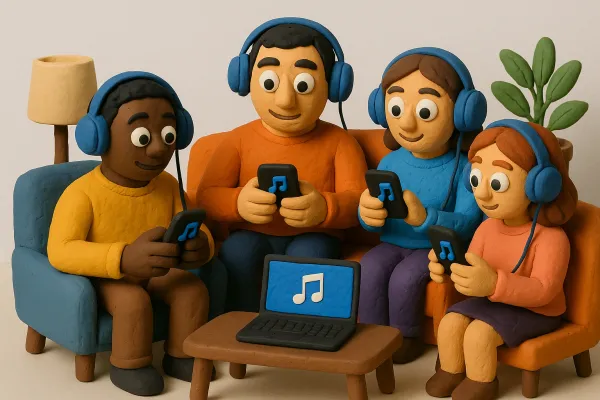How to Transfer Spotify Playlists to Apple Music: A Step-by-Step Guide for 2025

Switching from Spotify to Apple Music but worried about losing all your playlists? Don’t stress—it’s actually easier than you think. With the right tools and a bit of prep, you can move all your music over without breaking a sweat. Whether you’re using apps like TuneMyMusic or SongShift, or even going the manual route, this guide will walk you through every step. Let’s make sure your favorite playlists come along for the ride.
Key Takeaways
- Transferring Spotify playlists to Apple Music is straightforward with tools like TuneMyMusic and SongShift.
- Manual methods are available but can be time-consuming and limited.
- Some songs might be missing during the transfer, so double-check your playlists.
- Choose a reliable transfer tool to ensure a smoother experience.
- Prepare your accounts and playlists in advance to save time.
Why You Should Transfer Your Spotify Playlists to Apple Music
Benefits of Switching to Apple Music
Making the leap to Apple Music comes with some solid perks. First off, Apple Music’s sound quality is top-notch. If you’re someone who notices the little details in your favorite songs, you’ll love the lossless audio feature. Plus, Apple Music lets you download up to 100,000 songs to your library—perfect for offline listening without limits.
Then there’s the integration. If you’re already in the Apple ecosystem, Apple Music syncs seamlessly with your iPhone, iPad, Mac, and even your Apple Watch. Imagine controlling your playlists with just a tap on your wrist! And let’s not forget Siri—voice commands make skipping tracks or playing a specific song ridiculously easy.
Avoiding Playlist Loss During the Transition
We’ve all spent hours, maybe even years, building the perfect playlists. Losing those would be heartbreaking, right? Moving your playlists to Apple Music ensures that all your hard work doesn’t go to waste. Whether it’s your “Workout Jams” or that nostalgic “2000s Throwbacks” list, you won’t have to start from scratch.
And here’s the thing: transferring playlists isn’t as painful as it sounds. Tools like TuneMyMusic and FreeYourMusic make the process pretty straightforward, so you don’t have to worry about losing your favorite tracks.
Key Features of Apple Music That Spotify Lacks
While Spotify is great, Apple Music has a few tricks up its sleeve that might win you over. For one, Apple Music offers exclusive content like early album releases and artist interviews. If you’re a music nerd, this stuff is gold.
Another cool feature? The ability to listen to live radio stations like Beats 1. It’s like having a global radio station at your fingertips, with curated shows hosted by some of the biggest names in music. And let’s not forget the family sharing plan—up to six people can share one subscription, making it super cost-effective.
Switching to Apple Music isn’t just about trying something new—it’s about upgrading your music experience. With better sound quality, exclusive content, and seamless integration, it’s a no-brainer for anyone ready to make the move.
Top Tools to Transfer Spotify Playlists to Apple Music
Overview of Popular Playlist Transfer Apps
When it comes to moving your Spotify playlists to Apple Music, the good news is there are plenty of apps that make it a breeze. These tools do the heavy lifting, so you don’t have to manually recreate your playlists. Some of the most popular ones include:
- TuneMyMusic: A web-based tool that’s straightforward and works across multiple platforms.
- FreeYourMusic: Known for its speed and ease of use, this one’s a fan favorite.
- SongShift: Perfect for iOS users, with a clean interface and reliable performance.
Each of these apps comes with its own perks, so picking the right one depends on your needs and preferences.
If you’re looking for the ultimate list of options, check out our top 10 converters for Spotify to Apple Music.
How TuneMyMusic Simplifies the Process
TuneMyMusic is like the MVP of playlist transfer apps. It’s web-based, so there’s no need to download anything. Here’s how it works:
- Head to their website and select Spotify as your source.
- Log in to your Spotify account and choose the playlists you want to transfer.
- Pick Apple Music as your destination, log in, and let the magic happen.
The app scans your playlists and matches songs with Apple Music’s library. It’s quick, easy, and doesn’t require much effort on your part.
Why FreeYourMusic is a Fan Favorite
FreeYourMusic is all about simplicity. It’s available on both desktop and mobile, and the steps are super clear:
- Download the app and log into your Spotify account.
- Select the playlists you want to transfer.
- Log into Apple Music and let the app handle the rest.
What makes FreeYourMusic stand out is its accuracy. It minimizes missing tracks, which is a common issue with other tools. Plus, it supports a ton of other services if you ever decide to switch again.
Step-by-Step Guide to Using TuneMyMusic
Setting Up Your Spotify Account for Transfer
Alright, let’s get started. First, head over to the TuneMyMusic website. Once you’re there, click on the big, welcoming “Let’s Start” button. From here, you’ll need to choose Spotify as your source. This will redirect you to Spotify’s login page. Enter your credentials, and don’t forget to grant TuneMyMusic the necessary permissions. Without these permissions, the tool can’t access your playlists. If you’re worried about privacy, you can always revoke access later.
Here’s a quick checklist to make sure you’re ready:
- Make sure your Spotify account is active and logged in.
- Double-check that your playlists are public or shareable.
- Be prepared to grant permissions for TuneMyMusic.
Connecting Apple Music to TuneMyMusic
Now that Spotify is set up, it’s time to connect Apple Music. On the TuneMyMusic platform, select Apple Music as your destination. You’ll be prompted to log in to your Apple Music account. Just like with Spotify, you’ll need to allow TuneMyMusic to access your account. Once connected, the tool will be able to transfer your playlists seamlessly.
Pro Tip: If you’re transferring a lot of playlists, it might take a few minutes. Grab a coffee while TuneMyMusic does its magic!
Troubleshooting Common Issues
Sometimes, things don’t go as planned. Here are a few common hiccups and how to fix them:
- Missing Songs: If a song doesn’t transfer, it’s usually because it’s not available on Apple Music. You can manually search for and add these tracks later.
- Duplicate Tracks: Occasionally, you might end up with duplicate songs in your playlists. Use Apple Music’s built-in tools to clean these up.
- Login Problems: If you’re having trouble logging in, double-check your credentials and ensure you’re using the correct accounts.
TuneMyMusic is a lifesaver for transferring playlists, but it’s always a good idea to double-check everything once the transfer is complete.
And that’s it! With just a few clicks, you can move your Spotify playlists to Apple Music without breaking a sweat. Learn how to transfer Spotify playlists to Apple Music with ease using TuneMyMusic.
How to Use SongShift for Seamless Playlist Transfers
Downloading and Installing SongShift
First things first, grab SongShift from the App Store. It’s a free app, but there’s also a Pro version if you’re looking for extra features like batch transfers. Once it’s installed, open it up and hit "Get Started." This is where you’ll select Spotify and Apple Music as your music services. Don’t forget to log in to both accounts and give the app the permissions it needs to access your playlists. Without this step, the transfer won’t work!
Syncing Your Spotify and Apple Music Accounts
Now that the app is set up, it’s time to sync your accounts. SongShift calls each transfer setup a "Shift." Here’s how it works:
- Tap the "+" button in the top-right corner to create a new Shift.
- Choose Spotify as your source service. You’ll see a list of all your playlists.
- Select the playlist you want to transfer.
- For the destination, pick Apple Music. The app will automatically start matching your songs.
It’s that simple! Just repeat the process for each playlist you want to move. If you’ve got a lot of playlists, this might take a while, but the app does most of the heavy lifting for you.
Tips for a Smooth Transfer
- Double-check your playlists: Before starting, make sure your Spotify playlists are organized and don’t have duplicate tracks.
- Be patient: SongShift processes each song individually, so larger playlists might take some time.
- Review matches: Once the app finishes, it’ll show you the matched songs. If something doesn’t look right, you can edit or re-match the tracks before finalizing the transfer.
SongShift is a lifesaver for anyone switching music platforms. While the process isn’t instant, it’s way easier than manually recreating playlists.
If you’re looking for an alternative, SongShift is one of the best third-party apps out there for playlist transfers. It’s especially handy for iPhone users who rely on Apple Music as their primary music service.
Manual Methods to Transfer Playlists Without Third-Party Apps
Exporting Spotify Playlists as Files
Alright, let’s talk about doing this the old-school way. If you’re not into using apps or tools, you can manually export your Spotify playlists. Unfortunately, Spotify doesn’t have a built-in export feature, so you’ll need to get a little creative. Here’s how we can do it:
- Open your Spotify playlist and copy all the song titles and artist names. You can do this manually or use a browser extension to help.
- Paste the list into a spreadsheet program like Excel or Google Sheets. Make sure each song and artist is in its own column for clarity.
- Save the file as a CSV (Comma-Separated Values) file. This format is essential for importing into Apple Music later.
It’s a bit tedious, but it works if you’re determined to avoid third-party tools.
Importing Playlists into Apple Music
Now that you’ve got your playlist saved as a CSV file, it’s time to bring it into Apple Music. Here’s what we need to do:
- Open Apple Music on your computer (you’ll need the desktop version for this).
- Navigate to "File" > "Library" > "Import Playlist."
- Select your CSV file from earlier and let Apple Music do its thing. It’ll match the songs in your file to its library and add them to a new playlist.
Pro Tip: Some songs might not match perfectly, especially if they’re obscure or rare. Be ready to manually search for and add those tracks.
Limitations of Manual Transfers
Manual methods can be satisfying if you like having full control, but let’s be real—they’re not perfect. Here are a few challenges we’ve noticed:
- Time-Consuming: Copying and pasting song titles, creating spreadsheets, and manually importing takes a lot of effort.
- Missing Songs: If a track isn’t available on Apple Music, it won’t transfer. You’ll have to find alternatives or go without.
- No Metadata: Things like album art, release year, and other details won’t carry over. You’re just getting the song titles and artists.
If you’re okay with spending the extra time and effort, manual transfers can be a decent option. But let’s be honest—it’s not for everyone.
For a quicker and easier solution, you might want to consider syncing your Spotify and Apple Music accounts using tools like Easily sync your Spotify and Apple Music accounts. It’s worth it if you have a massive library to transfer.
Common Challenges When Transferring Playlists
Dealing with Missing Songs
One of the biggest headaches when transferring playlists is dealing with missing songs. Sometimes, tracks just don’t make it over because they aren’t available in the Apple Music catalog. This happens a lot with indie artists or older tracks. Services like TuneMyMusic usually notify you about these gaps, but it’s still up to you to find replacements or live without them.
Handling Duplicate Tracks
Ever finish transferring a playlist only to find the same song listed three times? Yeah, it’s annoying. Duplicate tracks often sneak in during the transfer process, especially if the metadata isn’t perfectly matched. Double-check your playlists after the move and clean them up manually if needed.
Ensuring Metadata Accuracy
Metadata—like song titles, artist names, and album info—can get scrambled during transfers. This is especially true for remixes or songs with multiple versions. If you notice weird titles or missing info, you’ll need to fix those manually on Apple Music.
Pro Tip: Always double-check your playlists after transferring. It’s better to spend a few minutes fixing errors now than to discover them when you’re in the mood to jam out later.
| Challenge | What Happens | How to Fix |
|---|---|---|
| Missing Songs | Tracks not available on Apple Music | Add similar songs manually |
| Duplicate Tracks | Same song appears multiple times | Remove duplicates manually |
| Metadata Issues | Incorrect or missing song details | Edit song info on Apple Music |
By keeping an eye out for these common issues, you can save yourself a lot of frustration. Transferring playlists isn’t perfect, but with a little patience, it’s totally doable.
Tips to Make Your Playlist Transfer Hassle-Free
Preparing Your Playlists in Advance
Before you dive into transferring playlists, take a moment to get organized. Trust us, a little prep can save a lot of frustration later. Start by reviewing your Spotify playlists. Are there songs you don’t listen to anymore? Maybe some duplicates hiding in there? Clean them up first. This way, you’re only moving the songs you actually care about.
- Delete old or unused playlists.
- Combine similar playlists into one if needed.
- Double-check for duplicate tracks.
Choosing the Right Transfer Tool
Not all transfer tools are created equal, and picking the wrong one can lead to headaches. If you’re moving just a few playlists, a free option like Free Your Music might work perfectly. On the other hand, if you’ve got a massive library, it might be worth investing in a premium tool for a smoother experience.
Here’s a quick comparison of popular tools:
| Tool | Free Version Limitations | Best For |
|---|---|---|
| Free Your Music | Transfers one playlist at a time | Casual users with smaller libraries |
| TuneMyMusic | Max 500 tracks for free | Budget-friendly transfers |
| SongShift | Limited features for free | Apple device enthusiasts |
Verifying Your Playlists Post-Transfer
Once the transfer is complete, don’t just assume everything went through perfectly. Take a few minutes to check your playlists in Apple Music. Are all your favorite tracks there? Any duplicates or missing songs? Fixing these issues early will save you from surprises later.
- Play a few tracks from each playlist to ensure they work.
- Search for any songs that didn’t transfer and add them manually.
- Remove duplicates if they popped up during the transfer.
Taking the time to double-check your playlists after the transfer can make all the difference in enjoying your music hassle-free.
By following these tips, you’ll make the whole process way less stressful. Happy listening!
Transferring your playlists can be a breeze if you follow a few simple tips. Start by organizing your songs and making sure they are all in one place. This will save you time and effort. Don't forget to check if the platforms you are using support the same file types. For more helpful advice and tools to make your playlist transfer easy, visit our website!
Wrapping It Up
So there you have it! Moving your Spotify playlists to Apple Music doesn’t have to be a headache. Whether you go with TuneMyMusic, Soundiiz, or one of the other tools we talked about, the process is pretty straightforward. Just follow the steps, and you’ll be jamming to your favorite playlists on Apple Music in no time. Honestly, it’s worth the few minutes it takes to set up—your music deserves to come with you. Happy listening!
Frequently Asked Questions
What is the easiest way to transfer Spotify playlists to Apple Music?
Using apps like TuneMyMusic or SongShift is the easiest way to transfer your playlists. These tools let you move songs quickly without much effort.
Can I transfer playlists from Spotify to Apple Music for free?
Yes, many tools like TuneMyMusic and FreeYourMusic offer free versions, but they may have limitations like fewer playlist transfers or ads.
Will all songs transfer correctly from Spotify to Apple Music?
Not always. Some songs might be missing if they are not available on Apple Music. Double-check your playlists after transferring.
Do I need to download any apps to transfer playlists?
It depends. Some tools like SongShift require an app download, while others like TuneMyMusic work directly through a web browser.
What happens to my Spotify playlists after transferring?
Your Spotify playlists remain unchanged. The transfer process simply copies them to Apple Music.
Can I transfer playlists manually without using any tools?
Yes, you can export your Spotify playlist as a file and then manually add the songs to Apple Music. However, this method is time-consuming and prone to errors.





